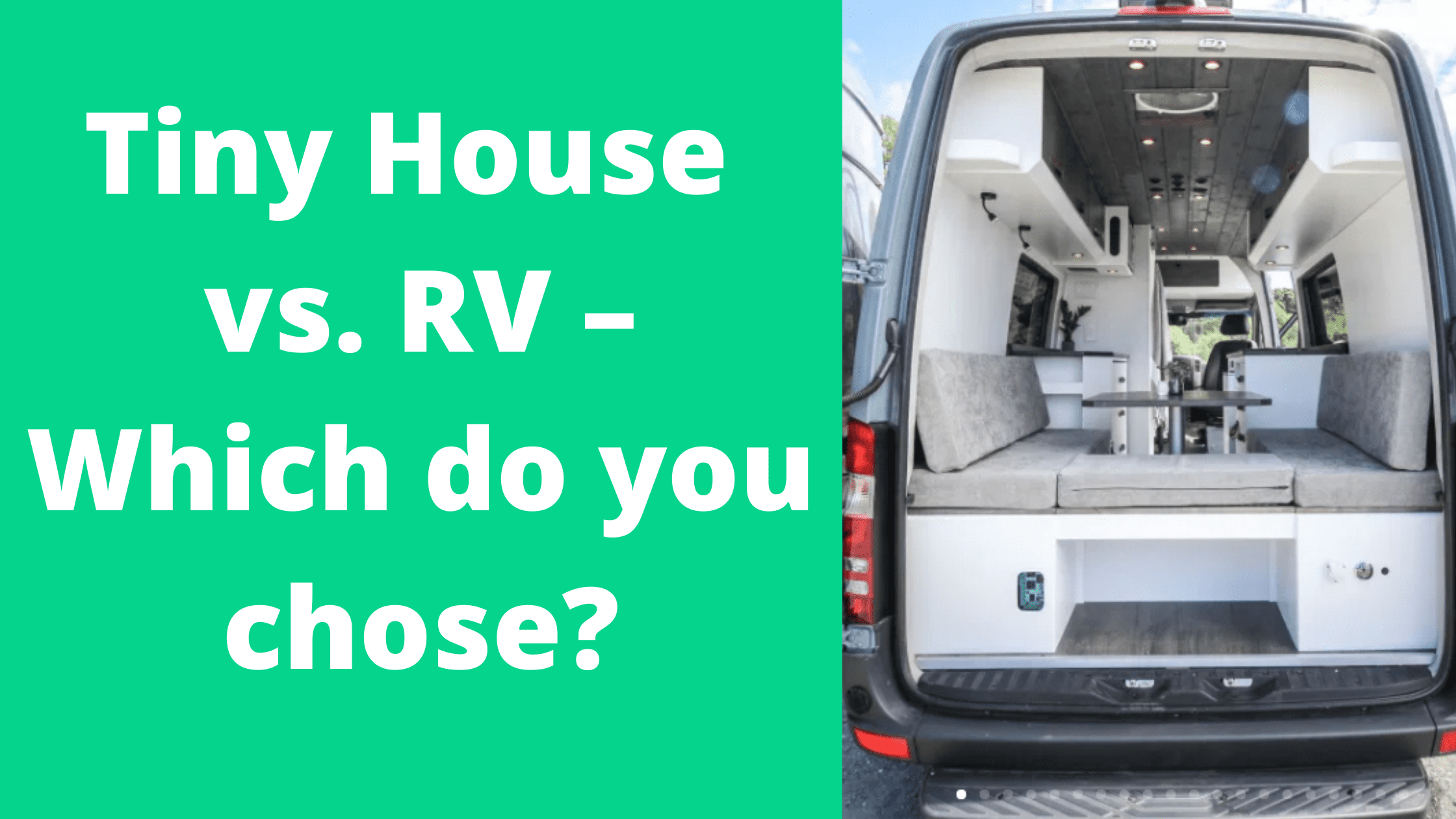The Tiny House movement has really taken off, with downsizing and living on a small-scale booming in popularity around the world. But within the tiny house trend there are many sub-sectors, from container homes to converted grain silos.
One particularly popular niche is RV living. After all, there are overlaps between tiny homes and RVs. Both offer the benefit of affordability, and both appeal to people looking to live a more minimalist lifestyle. But while an RV could count as a tiny home, most tiny homes are stationary.
Here we compare living in a stationary tiny home vs. living in an RV. Both have their individual perks and unique downsides. Ultimately, it’s your choice as you’re the one living in it but here’s a rundown of what to expect from both to help you to decide.
- RV living: simple and flexible
- Tiny house living: solid and secure
- What about a tiny house on wheels?
- So what’s better, a tiny house or RV?
RV living: simple and flexible
Perks of living in an RV
- Mobility
- This is the big one. In an RV, you can travel – all over the country if you want. You can see the world, all from aboard a lightweight and aerodynamic vehicle designed for life on the road.
- This is great if you work remotely – which more and more people are doing. Indeed, the number of remote workers has grown 44% in the last 5 years.
- Flexibility
- There are many different types of RV on the market. The RV category includes popup campers, truck campers, caravans, campervans, and motorhomes. RVs also come in lots of different sizes, ranging from a basic trailer all the way up to a Class 8 motorhome which can sleep up to 10 people and has a full-sized bathroom.
- There’s also the option of RV extensions that pop out to create more space.
- Cost
- Building a tiny house is, in general, more expensive than buying a standard RV, which can cost as little as $10,000 – compared to an average of $59,884 for building a tiny home. While you can build tiny homes for as little as $10,000, this is not the norm.
- Freedom
- When living in an RV, you don’t have to rely on infrastructure such as electricity, opting instead for a generator. Similarly, you don’t have to be hooked up to a mains water and sewer system. You are technically off-grid.
- Of course, this also has its downsides. Portable toilets are not the most pleasant of things.
- Speed
- RVs are pre-built, ready to go. Are you looking for somewhere to live right now? You can buy an RV, pick it up the same day, and drive off on an adventure then and there.
- A tiny house takes a lot longer to reach a liveable state, especially if you’re building it from scratch.
- Insurance
- Insurance can be expensive as it needs to include automotive coverage but because RVs have been around for a long time, compared to tiny homes, sorting out insurance is far less of a headache – as long as you fulfill certain requirements.
- You can even buy coverage that allows you to live in your RV full-time.
- Less conspicuous
- RVs on the road are a common sight. On the other hand, people are still getting used to tiny homes and there can be a stigma around them in some places.
Downsides to living in an RV
- Less hard-wearing
- RVs are not designed for year-round use. They aren’t particularly sturdy and aren’t insulated to the standard of a conventional home. This means you might have to move your RV somewhere warm for the winter months.
- Similarly, RVs require a lot of maintenance and repairs. Water damage is a common problem with RVs, for example.
- Not so eco-friendly
- Materials used in mass-manufactured RVs can be less than environmentally friendly, such as off-gassing formaldehyde used in glues and particleboard furnishings.
- While it’s possible to find eco-friendly campervans, no matter which way you spin it, driving around a lot is not great for the environment.
- Not so easy to customize
- Most RVs are a certain shape and layout. After all, there’s only one place the driver can sit. And because you’re on the road, you have to consider an even distribution of weight, which puts some limitations on your design freedom.
- Finding places to stay
- You can park your RV in a campground but you’ll have to pay. These cost between $25 and $80 a night – which is a lot less than paying rent, but still a financial outlay to consider.
- Bear in mind, however, that the longer you stay, the cheaper it tends to be.
- Many places won’t let you stay long-term – but there are permanent RV parking lots too.
- Not having a fixed home could be tiring and cause certain problems. For example, what if you get a flat tire out on the road late at night?
- Depreciate in value
- Houses more or less hold their value. Vehicles, on the other hand, tend to depreciate due to wear and tear and increased mileage.
- Plus, you’re going to have to shell out quite a lot on gas too.
Tiny house living: solid and secure
Advantages of living in a tiny house
- It’s just like a conventional house – but smaller
- Aesthetically, tiny houses are more attractive for many people. They look and feel like a proper home. With an RV, you might have the sense of being stuck on an endless camping trip.
- When furnishing your tiny home, you don’t have to think about how things will fare on the road which gives you greater flexibility.
- Tiny houses are often bigger too. While some RVs have slide-out room expansions, these slide-outs are notoriously problematic, tending to break or leak, and can be expensive to mend.
- Having a sense of home
- Living in an RV, out on the road, you constantly have to adjust to a new place and learn where everything else is. This can be difficult, especially if you need to go to the doctors, for example.
- Our sense of ‘home’ is very important to mental well-being. According to The Health Foundation, a home that makes us feel safe and happy is one that stable and secure, provides for our daily needs, and is connected to the community. You might not have these advantages when living in an RV.
- More sturdy and hard-wearing
- Tiny homes are weatherproofed to withstand diverse conditions. They are properly insulated and designed for year-round living. They make use of higher-quality materials because they have been designed as a full-time residence.
- The furnishings of RVs aren’t designed to withstand lots of use. Manufacturers assume they’re only going to be used part of the year.
- Customizable
- RVs tend to come in one standard model. Tiny homes offer more flexibility when it comes to shape and size. You can create a home that is unique to you, specifically designed to fulfill your needs.
Disadvantages of living in a tiny house
- Expense
- In general, tiny homes are a lot more expensive to build than an RV – although it is possible to do it for less than $12,000.
- Time and effort to build
- The average tiny home takes 500 hours to build for an amateur DIY-er. While a professional can do it in around 120 hours, you are probably looking at at least a year, start to finish, before you can live in your tiny home – unless you plan to work full-time on the build.
- Infrastructure
- Tiny homes need to be connected to a mains sewer and electrical system which limits your freedom in terms of where you live. Plus, utility bills can cost a lot of money.
- Of course, there is the option to go off-grid with solar panels, rainwater collecting systems, and composting toilets.
- Legal considerations
- Getting a building permit and insurance can be quite a headache and involve a lot of bureaucracy. There’s currently no standard approach to tiny home insurance.
What about tiny homes on wheels?
At first glance, it seems like a tiny house on wheels could offer the perks of both ways of living.
However, it’s important to understand that tiny houses on wheels aren’t quite the same as an RV.
They are frequently a lot heavier and harder to maneuver, and travel can put stress on the structure. Usually, these tiny houses on wheels are designed with the purpose of side-stepping local building codes rather than expressly for life on the road.
So what’s better, a tiny house or RV?
Choosing between a tiny house and an RV ultimately depends on you and your lifestyle.
Do you work remotely? Do you relish freedom? For the ability to travel, freedom from legal hurdles, and minimum expense, go for an RV.
Have you got a bit more money to spend and are looking for something unique and homely? Somewhere to settle down and build a life? A chance to live in a more eco-friendly way? In that case, a tiny home may suit you best.


